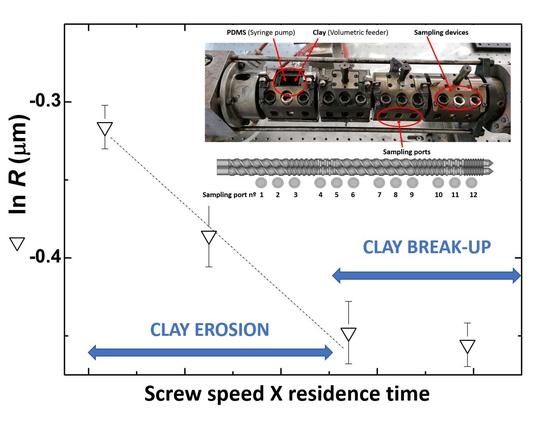In-Line Rheo-Optical Investigation of the Dispersion of Organoclay in a Polymer Matrix during Twin-Screw Compounding
Abstract
:1. Introduction
- -
- A rheo-optical die is coupled to a small-scale prototype twin screw extruder. The in situ characterization of the CPNC morphology and viscosity bypasses all issues related to a possible post-extrusion structural rearrangement.
- -
- A model CPNC, namely an organo-modified montmorillonite in a polydimethylsiloxane (PDMS), is used. This CPNC can be processed at ambient or low temperatures (up to 100 °C, which is well below the onset for PDMS or organo-clay thermal degradation [24]). Indeed, PDMS with relatively low molecular mass has been used in the CPNC literature [25,26] as the rheological study of polymer dynamics in the presence of clay is readily amenable at room temperature. Similarly, PDMS has been used to study flow-induced structures in colloidal suspensions (see, e.g., [27] and references therein).
- -
- Processing this CPNC avoids the need to superimpose polymer melting with mixing.
2. Materials and Methods
2.1. Materials
2.2. Compounding and In-Process Characterization of CPNC
2.3. Off-Line Characterization of CPNC
3. Results and Discussion
3.1. Rheological Characterization of the Polymer Matrix
3.2. Effect of Screw Speed
3.3. Effect of Temperature
3.4. Separating the Effects of Residence Time and Stress on the Level of Clay Dispersion
4. Conclusions
Author Contributions
Funding
Institutional Review Board Statement
Informed Consent Statement
Conflicts of Interest
References
- Vaia, R.A.; Gianelis, E.P. Polymer melt intercalation in organically-modified layered silicates: Model predictions and experiments. Macromolecules 1997, 30, 8000–8009. [Google Scholar] [CrossRef]
- Cho, J.W.; Paul, D.R. Nylon 6 nanocomposites by melt compounding. Polymer 2001, 42, 1083–1094. [Google Scholar] [CrossRef]
- Alexandre, M.; Dubois, P. Polymer-layered silicate nanocomposites: Preparation, properties and uses of a new class of materials. Mat. Sci. Eng. R 2000, 28, 1–63. [Google Scholar] [CrossRef]
- Tjong, S.C. Structural and mechanical properties of polymer nanocomposites. Mat. Sci. Eng. R 2006, 53, 73–197. [Google Scholar] [CrossRef]
- Delva, L.; Ragaert, K.; Degrieck, J.; Cardon, L. The effect of multiple extrusions on the properties of montmorillonite filled polypropylene. Polymers 2014, 6, 2912–2927. [Google Scholar] [CrossRef] [Green Version]
- Slany, M.; Jankovic, L.; Madejova, J. Structural characterization of organo-monmorillonites prepared from a series of primary alkylamines salts: Mid-IR and near-IR study. Appl. Clay Sci. 2019, 176, 11–20. [Google Scholar] [CrossRef]
- Ali, F.; Ullah, H.; Ali, Z.; Rahim, F.; Khan, F.; Rehman, Z.U. Polymer-clay nanocomposites, preparations and current applications: A review. Curr. Nanomat. 2016, 1, 83–95. [Google Scholar] [CrossRef]
- Dennis, H.R.; Hunter, D.L.; Chang, D.; Kim, S.; White, J.L.; Paul, D.R. Effect of melt processing conditions on the extent of exfoliation in organoclay-based nanocomposites. Polymer 2001, 42, 9513–9522. [Google Scholar] [CrossRef]
- Bousmina, M. Study of intercalation and exfoliation processes in polymer nanocomposites. Macromolecules 2006, 39, 4259–4263. [Google Scholar] [CrossRef]
- Fornes, T.D.; Yoon, P.J.; Keskkula, H.; Paul, D.R. Nylon 6 nanocomposites: The effect of matrix molecular weight. Polymer 2001, 42, 9929–9940. [Google Scholar] [CrossRef]
- Vergnes, B. Influence of processing conditions on the preparation of clay-based nanocomposites by twin-screw extrusion. Int. Polym. Proc. 2019, 34, 482–501. [Google Scholar] [CrossRef]
- Lertwimolnun, W.; Vergnes, B. Effects of processing conditions on the formation of polypropylene/organoclay nanocomposites in a twin screw extruder. Polym. Eng. Sci. 2006, 46, 314–323. [Google Scholar] [CrossRef]
- Domenech, T.; Peuvrel-Disdier, E.; Vergnes, B. Influence of twin screw processing conditions on structure and properties of polypropylene-organoclay nanocomposites. Int. Polym. Proc. 2012, 27, 517–526. [Google Scholar] [CrossRef]
- Borse, N.K.; Kamal, M.R. Estimation of stresses required for exfoliation of clay particles in polymer nanocomposites. Polym. Eng. Sci. 2009, 49, 641–650. [Google Scholar] [CrossRef]
- Reyna-Valencia, A.; Deyrail, Y.; Bousmina, M. In situ follow-up of the intercalation process in a clay/polymer nanocomposite model system by rheo-XRD analysis. Macromolecules 2010, 43, 354–361. [Google Scholar] [CrossRef]
- Giraldi, A.L.F.M.; Bizarria, M.T.M.; Silva, A.A.; Velasco, J.I.; d’Avila, M.A.; Mei, L.H.I. Effects of extrusion conditions on the properties of recycled poly(ethylene terephthalate)/nanoclay nanocomposites prepared by a twin-screw extruder. J. Appl. Polym. Sci. 2008, 108, 2252–2259. [Google Scholar] [CrossRef]
- Tanoue, S.; Utracki, L.A.; Garcia-Rejon, A.; Tatibouët, J.; Cole, K.C.; Kamal, M.R. Melt compounding of different grades of polystyrene with organoclay. Part 1: Compounding and characterization. Polym. Eng. Sci. 2004, 44, 1046–1060. [Google Scholar] [CrossRef]
- Watzeels, N.; Van Durme, K.; Miltner, H.E.; Block, C.; Van Assche, G.; Van Mele, B.; Bogdanov, B.; Rahier, H. Optimization of extrusion parameters for preparing PCL-layered silica nanocomposites supported by modeling of twin-screw extrusion. Macromol. Mater. Eng. 2013, 298, 210–220. [Google Scholar] [CrossRef]
- Barbas, J.M.; Machado, A.V.; Covas, J.A. Processing conditions effects on dispersion evolution in a twin-screw extruder: Polypropylene-clay nanocomposites. Chem. Eng. Technol. 2014, 37, 257–266. [Google Scholar] [CrossRef]
- Teixeira, P.F.; Covas, J.A.; Hilliou, L. In-process assessment of clay dispersion in PLA during melt compounding: Effects of screw speed and filler content. Polym. Degrad. Stabil. 2020, 177, 109190. [Google Scholar] [CrossRef]
- Wang, Y.; Chen, F.B.; Wu, K.C. Twin screw extrusion compounding of propylene/organoclay nanocomposites modified by maleated polypropylenes. J. Appl. Polym. Sci. 2004, 93, 100–112. [Google Scholar] [CrossRef]
- Zhu, L.; Xanthos, M. Effects of process conditions and mixing protocols on structure of extruded polypropylene nanocomposites. J. Appl. Polym. Sci. 2004, 93, 1891–1899. [Google Scholar] [CrossRef]
- Pogodina, N.V.; Cerclé, C.; Avérous, L.; Thomann, R.; Bouquey, M.; Muller, R. Processing and characterization of biodegradable polymer nanocomposites: Detection of dispersion state. Rheol. Acta 2008, 47, 543–553. [Google Scholar] [CrossRef]
- Camino, G.; Lomakin, S.M.; Lazzari, M. Polydimethylsiloxane thermal degradation part 1. Kinetics aspects. Polymer 2001, 42, 2395–2402. [Google Scholar] [CrossRef]
- Zhu, Y.; Cardinaels, R.; Mewis, J.; Moldenaers, P. Rheological properties of PDMS/clay nanocomposites and their sensitivity to microstructure. Rheol. Acta 2009, 48, 1049–1058. [Google Scholar] [CrossRef] [Green Version]
- Krishnamoorti, R.; Vaia, R.A.; Giannelis, E.P. Structure and dynamics of polymer-layered silicate nanocomposites. Chem. Mater. 1996, 8, 1728–1734. [Google Scholar] [CrossRef]
- Vermant, J. Large-scale structures in sheared colloidal suspensions. Curr. Opin. Colloid Interface Sci. 2001, 6, 489–495. [Google Scholar] [CrossRef]
- Burnside, D.; Giannelis, V.P. Synthesis and properties of new poly(dimethylsiloxane) nanocomposites. Chem. Mater. 1995, 7, 1597–1600. [Google Scholar] [CrossRef]
- Teixeira, P.F.; Sutera, F.; Scaffaro, R.; Covas, J.A.; Hilliou, L. Multi-parameter in-process monitoring of clay dispersion during melt compounding with PLA. Express Polym. Lett. 2019, 13, 276–285. [Google Scholar] [CrossRef]
- Teixeira, P.F.; Ferrás, L.L.; Hilliou, L.; Covas, J.A. A new double-slit rheometrical die for in-process characterization and extrusion of thermo-mechanically sensitive polymer systems. Polym. Test. 2018, 66, 137–145. [Google Scholar] [CrossRef]
- Vermant, J.; Ceccia, S.; Dolgovskij, M.K.; Maffetone, P.L.; Macosko, C.W. Quantifying dispersion of layered nanocomposite via melt rheology. J. Rheol. 2007, 51, 429–450. [Google Scholar] [CrossRef]
- Wang, J.-S.; Porter, R.S. On the viscosity-temperature behavior of polymer melts. Rheol. Acta 1995, 34, 496–503. [Google Scholar] [CrossRef]
- Cross, M.M. Rheology of non-Newtonian fluids: A new flow equation for pseudoplastic systems. J. Colloid Sci. 1965, 20, 417–437. [Google Scholar] [CrossRef]
- Costa, S.; Teixeira, P.F.; Covas, J.A.; Hilliou, L. Assessment of piezoelectric sensors for the acquisition of steady melt pressures in polymer extrusion. Fluids 2019, 4, 66. [Google Scholar] [CrossRef] [Green Version]
- Dykes, L.M.C.; Torkelson, J.M.; Burghardt, W.R. Shear-induced orientation in well-exfoliated polystyrene/clay nanocomposites. Macromolecules 2012, 45, 1622–1630. [Google Scholar] [CrossRef]
- Debye, P.; Anderson, H.R.; Brumberger, H. Scattering by an inhomogeneous solid II. The correlation function and its application. J. Appl. Phys. 1957, 28, 679–683. [Google Scholar] [CrossRef]
- Kerker, M. The Scattering of Light and Other Electromagnetic Radiation; Academic Press: New York, NY, USA, 1969. [Google Scholar]
- Heck, B.; Kawai, T.; Strobl, G. Time dependent light attenuation measurements used in studies of the kinetics of polymer crystallization. Polymer 2006, 47, 5538–5543. [Google Scholar] [CrossRef]
- Bur, J.A.; Lee, Y.-H.; Roth, S.C.; Start, P.R. Measuring the extent of exfoliation in polymer/clay nanocomposites using real-time process monitoring methods. Polymer 2005, 46, 10908–10918. [Google Scholar] [CrossRef]
- Kohlbruger, K. Co-Rotating Twin Screw Extruders; Carl Hanser Verlag: Munich, Germany, 2007. [Google Scholar]
- Teixeira, P.F.; Maia, J.M.; Covas, J.A.; Hilliou, L. In-line particle size assessment of polymer suspensions during processing. Polym. Test. 2014, 37, 68–77. [Google Scholar] [CrossRef]
- Einstein, A. Eine neue Bestimmung der Moleküldimension. Ann. Phys. Leipz. 1906, 19, 289–306. [Google Scholar] [CrossRef] [Green Version]
- Einstein, A. Berichtigung zu meiner Arbeit: Eine neue Bestimmung der Moleküldimension. Ann. Phys. Leipz. 1911, 34, 591–592. [Google Scholar] [CrossRef] [Green Version]
- Scurati, A.; Feke, D.L.; Manas-Zloczower, I. Analysis of the kinetics of agglomerate erosion in simple shear flows. Chem. Eng. Sci. 2005, 60, 6564–6573. [Google Scholar] [CrossRef]
- Domingues, N.; Gaspar-Cunha, A.; Covas, J.A.; Camesasca, M.; Kaufman, M.; Manas-Zloczower, I. Dynamics of filler size and spatial distribution in a plasticating single screw extruder-modelling and experimental observations. Int. Polym. Process. 2010, 25, 188–198. [Google Scholar] [CrossRef]
- Kasaliwal, G.R.; Vilmow, T.; Pegel, S.; Pötschke, P. Polymer-Carbon Nanotube Composites—Preparation, Properties and Applications; MacNally, T., Pötschke, P., Eds.; Series in Composite Science and Engineering; Woodhead Publishing: Cambridge, UK, 2011; pp. 92–132. [Google Scholar]
- Hansen, S.; Khakhar, D.V.; Ottino, J.M. Dispersion of solids in nonhomogeneous viscous fluids. Chem. Eng. Sci. 1998, 53, 1803–1817. [Google Scholar] [CrossRef]
- Rwei, S.P.; Manas-Zloczower, I.; Feke, D.L. Characterization of agglomerate dispersion by erosion in shear flows. Polym. Eng. Sci. 1991, 31, 558–562. [Google Scholar] [CrossRef]
- Collin, V.; Boudimbou, I.; Peuvrel-Disdier, E. New insights in dispersion mechanisms of carbon black in a polymer matrix under shear by rheo-optics. J. Appl. Polym. Sci. 2013, 127, 2121–2131. [Google Scholar] [CrossRef] [Green Version]
- Ferrás, L.L.; Fernandes, C.; Semyonov, D.; Nóbrega, J.M.; Covas, J.A. Dispersion of grafite nanoplates in polypropylene by melt mixing: The effects of hydrodynamic stresses and residence time. Polymers 2021, 13, 102. [Google Scholar] [CrossRef]
- Yamada, H.; Manas-Zloczower, I.; Feke, D.L. Influence of matrix infiltration on the dispersion kinetics of carbon black agglomerates. Powder Technol. 1997, 92, 163–169. [Google Scholar] [CrossRef]
- Yamada, H.; Manas-Zloczower, I.; Feke, D.L. Observation and analysis of the infiltration of polymer liquids into carbon black agglomerates. Chem. Eng. Sci. 1998, 53, 1963–1972. [Google Scholar] [CrossRef]
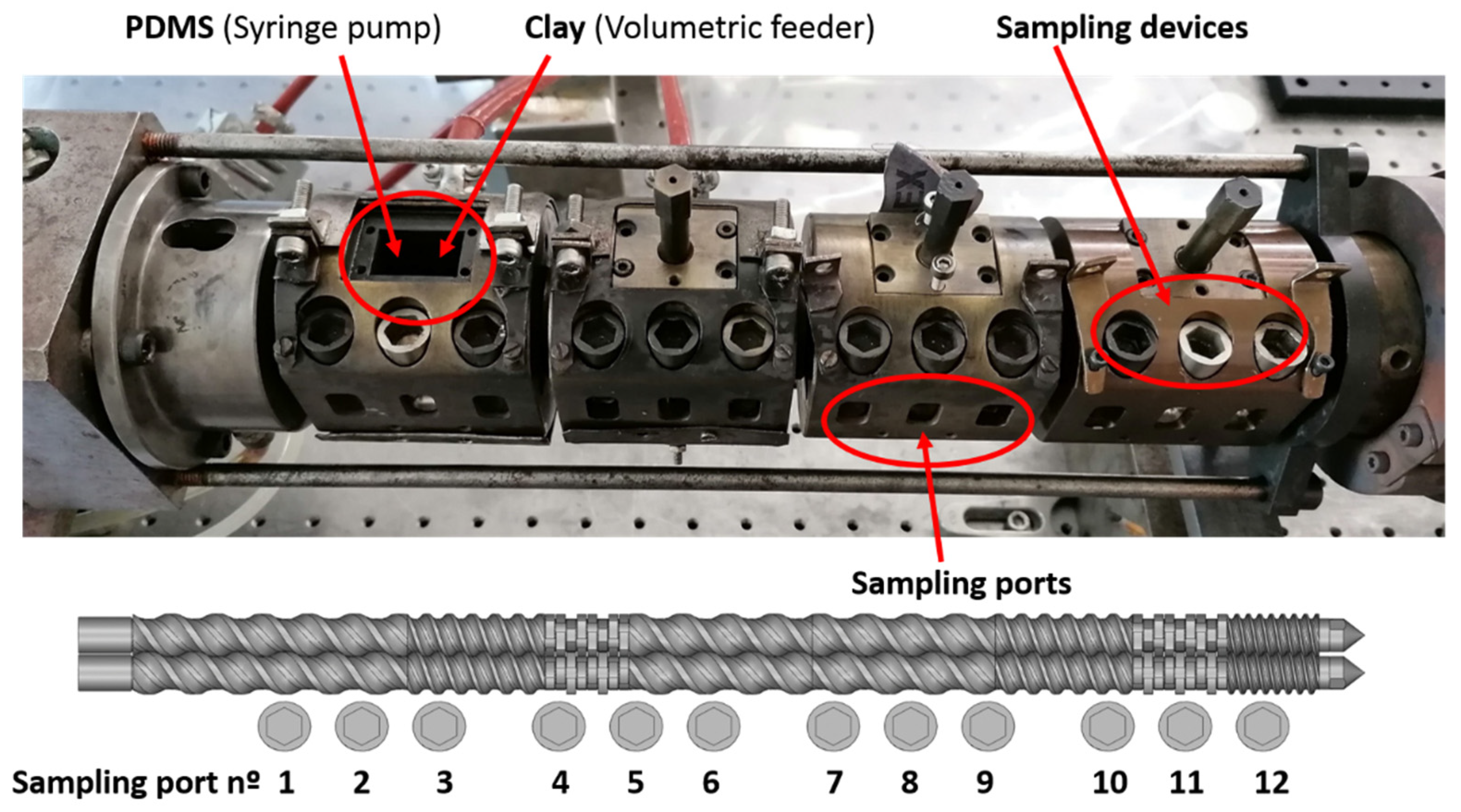

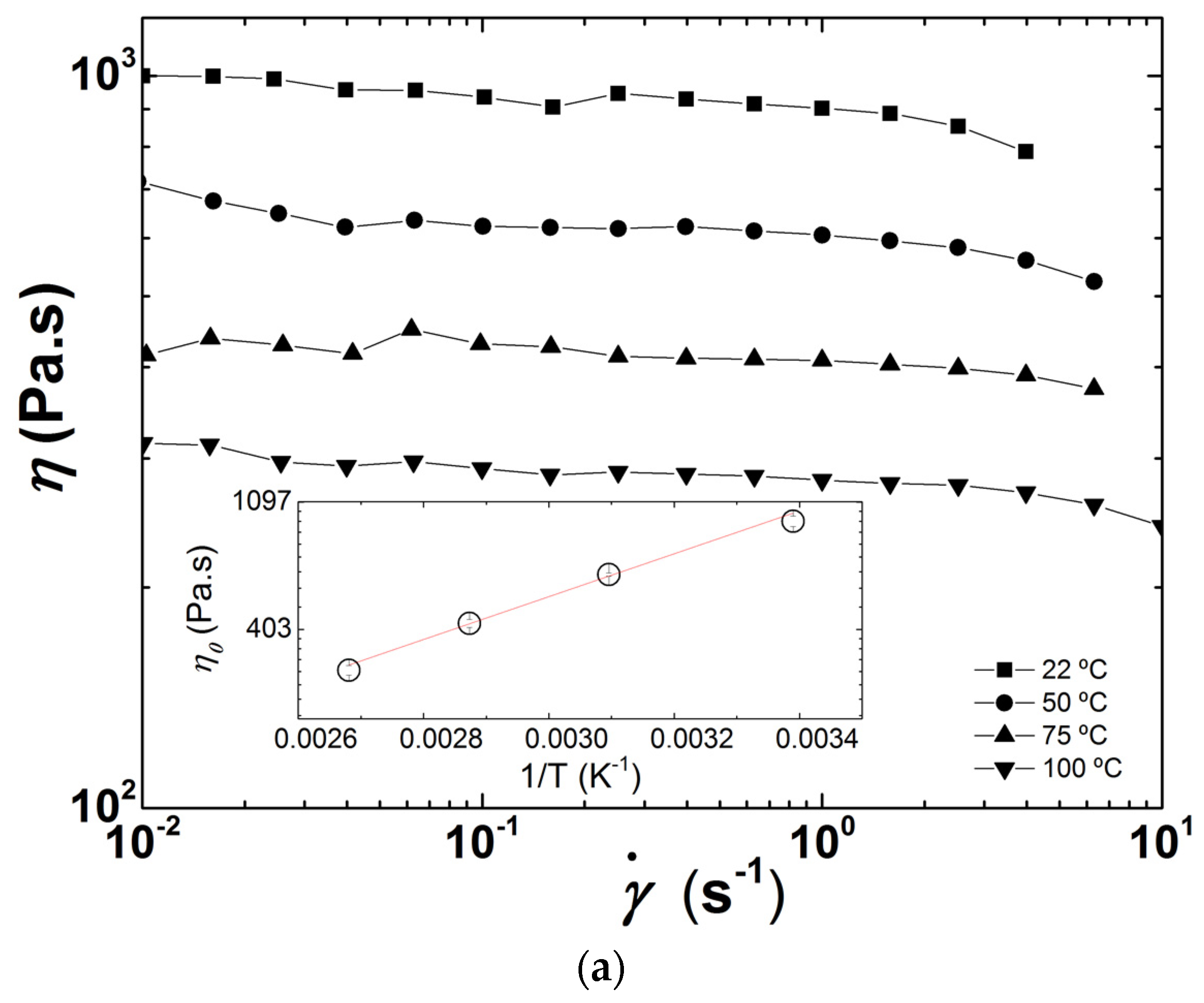
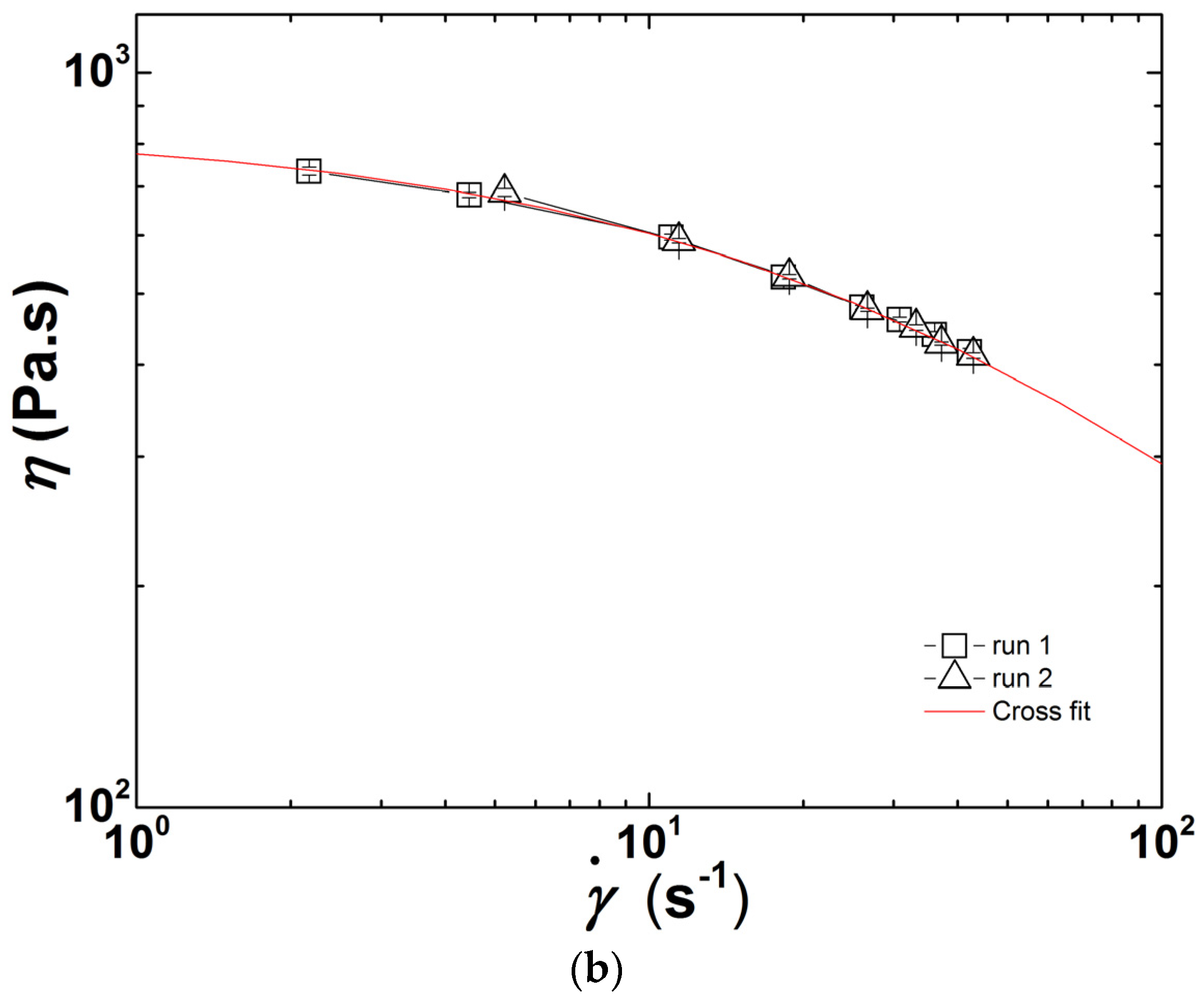
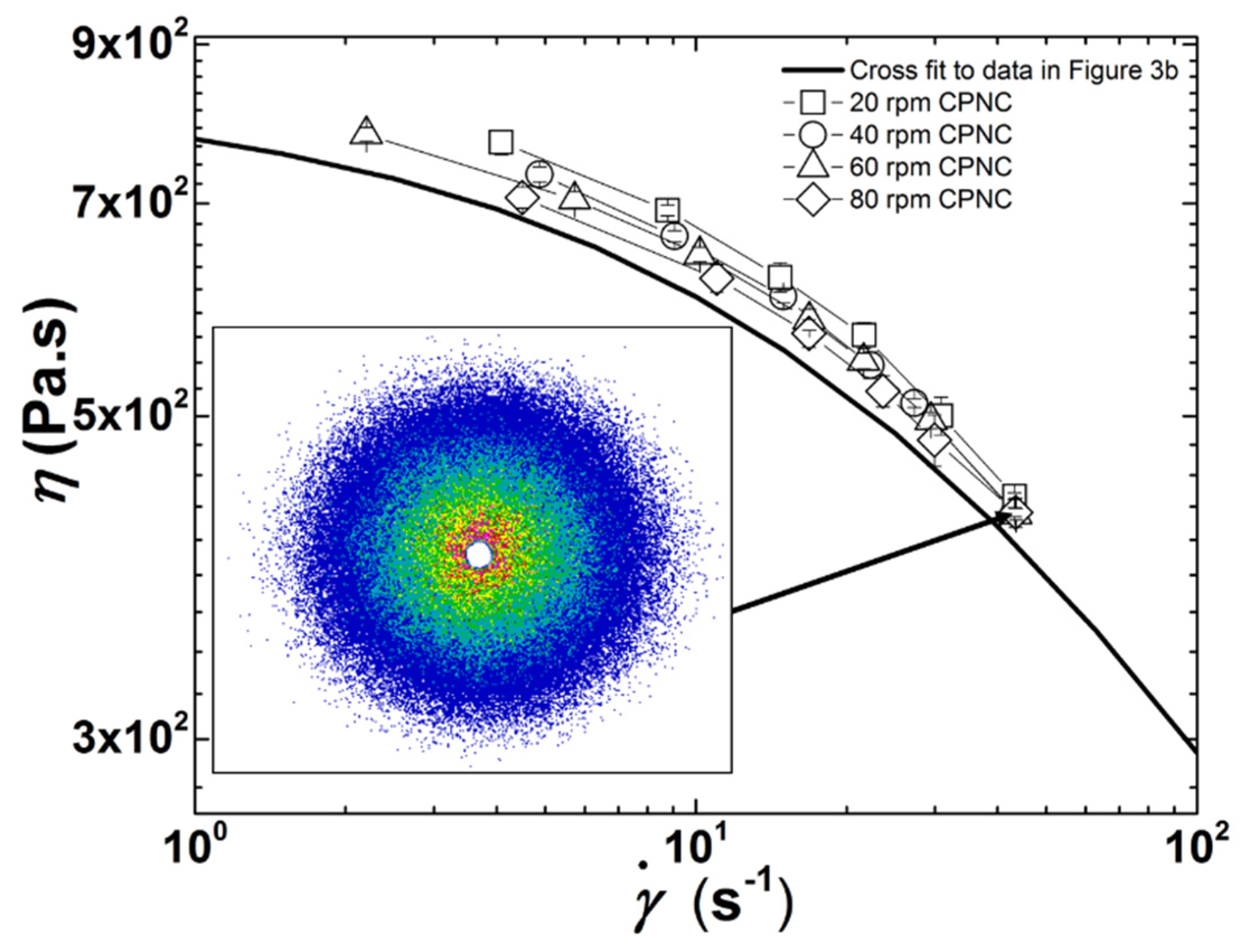

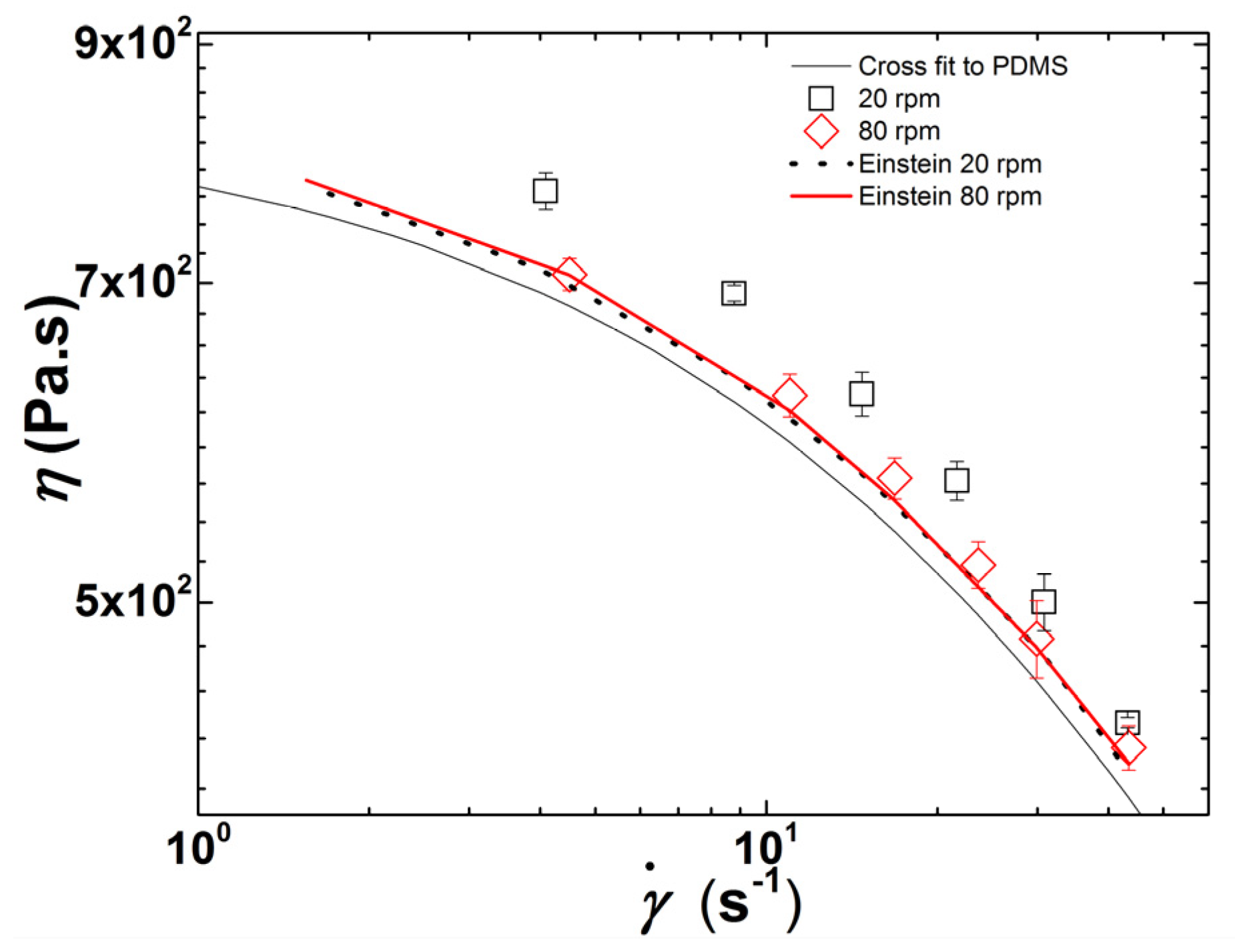
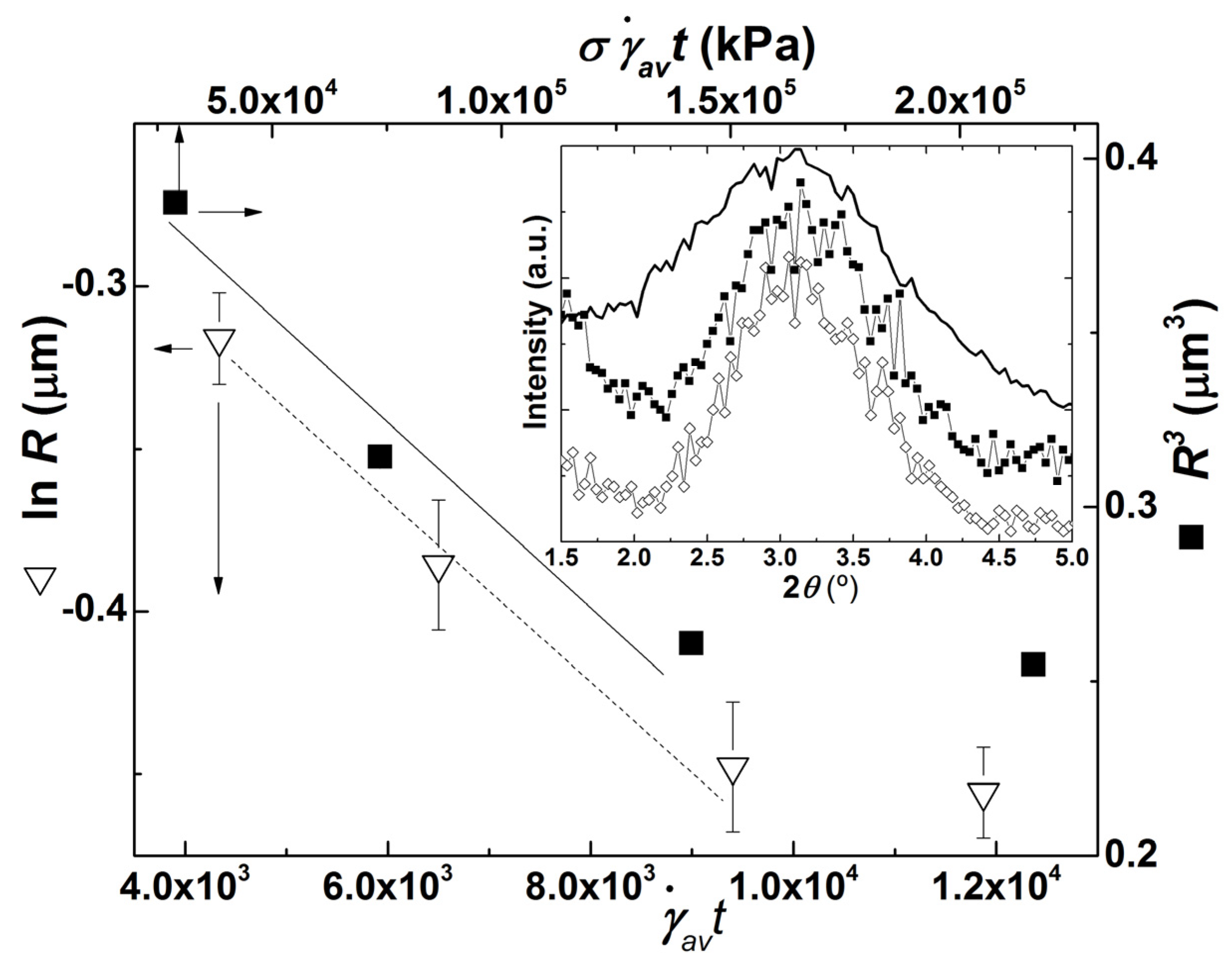
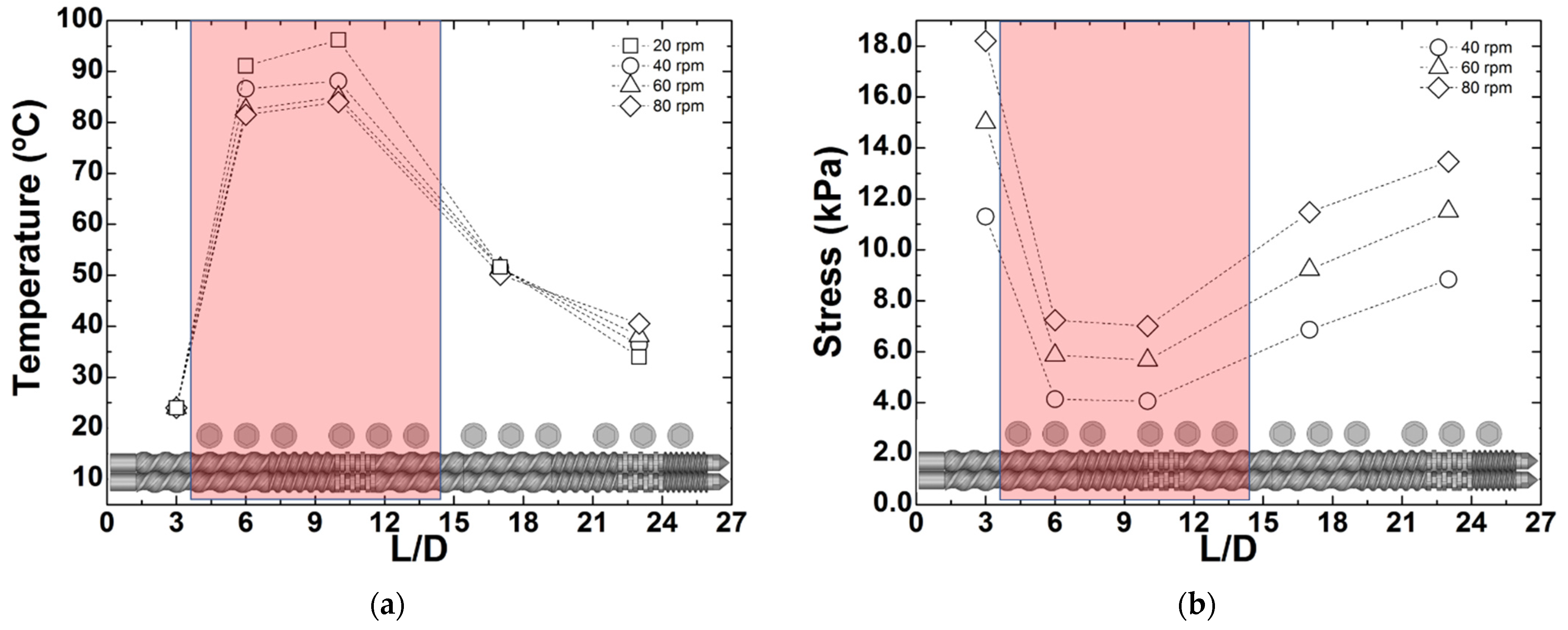


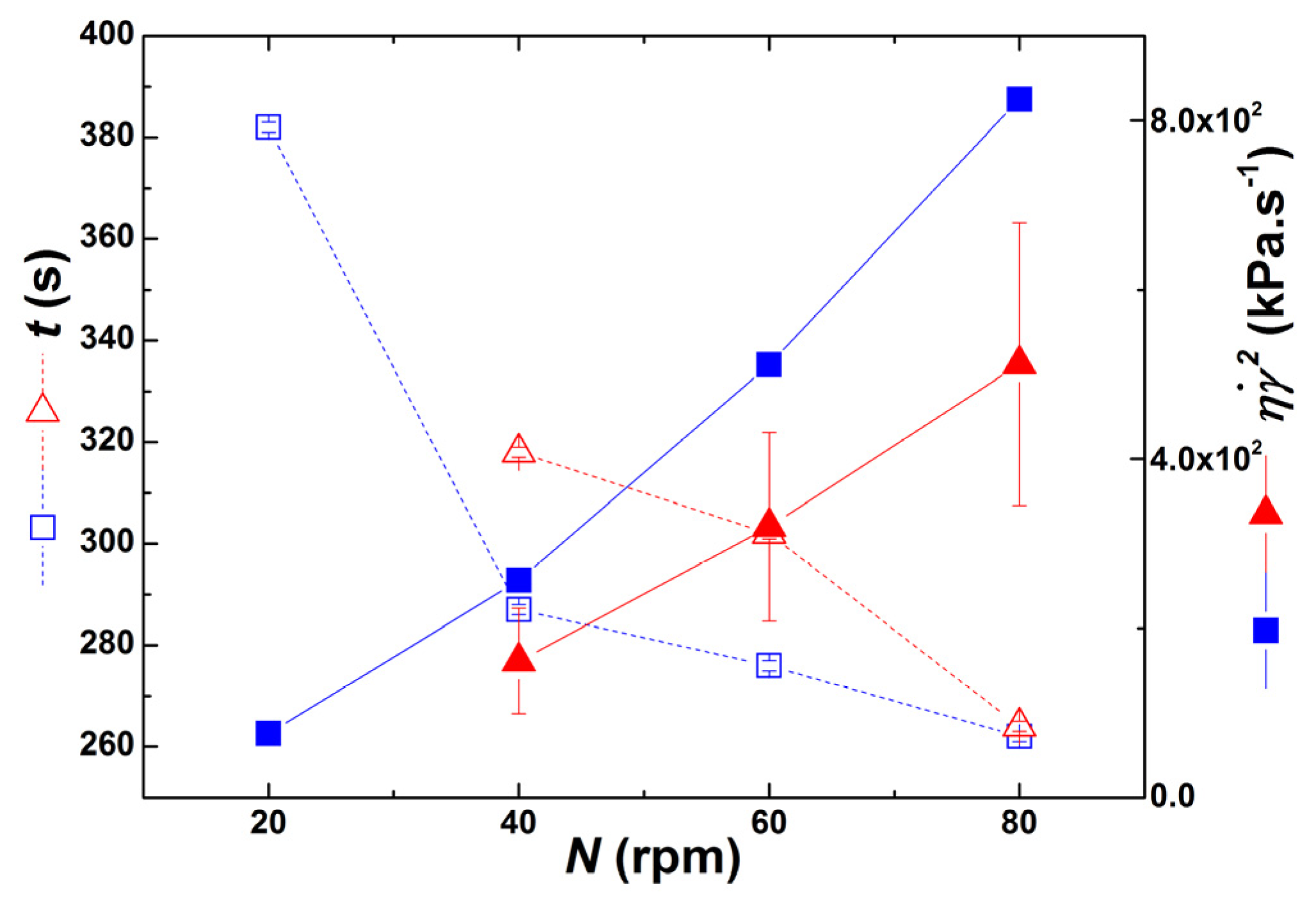



| N (rpm) | t (s) a | σav (Pa) c | σmax (Pa) c | |
|---|---|---|---|---|
| 20 | 382.5 | 11 | 6671 | 53,917 |
| 40 | 286.6 | 23 | 11,313 | 72,458 |
| 60 | 276.4 | 34 | 15,037 | 85,102 |
| 80 | 261.8 | 45 | 18,193 | 94,988 |
| N = 40 rpm | = 4 s−1 | = 10 s−1 | = 43 s−1 | |||
| R(μm) | ϕ(%) | R(μm) | ϕ(%) | R(μm) | ϕ(%) | |
| No heating | 0.68 ± 0.01 | 1.18 ± 0.05 | 0.66 ± 0.01 | 1.24 ± 0.06 | 0.67 ± 0.01 | 1.20 ± 0.05 |
| Heating | 0.58 ± 0.01 | 1.42 ± 0.04 | 0.58 ± 0.01 | 1.39 ± 0.03 | 0.61 ± 0.01 | 1.32 ± 0.05 |
| N = 60 rpm | = 4 s−1 | = 10 s−1 | = 43 s−1 | |||
| R(μm) | ϕ(%) | R(μm) | ϕ(%) | R(μm) | ϕ(%) | |
| No heating | 0.64 ± 0.01 | 1.26 ± 0.05 | 0.64 ± 0.01 | 1.30 ± 0.06 | 0.62 ± 0.01 | 1.38 ± 0.05 |
| Heating | 0.58 ± 0.01 | 1.35 ± 0.03 | 0.58 ± 0.01 | 1.45 ± 0.05 | 0.63 ± 0.01 | 1.30 ± 0.06 |
| N = 80 rpm | = 4 s−1 | = 10 s−1 | = 43 s−1 | |||
| R(μm) | ϕ(%) | R(μm) | ϕ(%) | R(μm) | ϕ(%) | |
| No heating | 0.63 ± 0.01 | 1.32 ± 0.04 | 0.62 ± 0.01 | 1.27 ± 0.05 | 0.62 ± 0.01 | 1.42 ± 0.06 |
| Heating | 0.63 ± 0.01 | 1.23 ± 0.04 | 0.63 ± 0.01 | 1.25 ± 0.03 | 0.63 ± 0.01 | 1.31 ± 0.03 |
Publisher’s Note: MDPI stays neutral with regard to jurisdictional claims in published maps and institutional affiliations. |
© 2021 by the authors. Licensee MDPI, Basel, Switzerland. This article is an open access article distributed under the terms and conditions of the Creative Commons Attribution (CC BY) license (https://creativecommons.org/licenses/by/4.0/).
Share and Cite
Teixeira, P.F.; Covas, J.A.; Hilliou, L. In-Line Rheo-Optical Investigation of the Dispersion of Organoclay in a Polymer Matrix during Twin-Screw Compounding. Polymers 2021, 13, 2128. https://doi.org/10.3390/polym13132128
Teixeira PF, Covas JA, Hilliou L. In-Line Rheo-Optical Investigation of the Dispersion of Organoclay in a Polymer Matrix during Twin-Screw Compounding. Polymers. 2021; 13(13):2128. https://doi.org/10.3390/polym13132128
Chicago/Turabian StyleTeixeira, Paulo F., José A. Covas, and Loïc Hilliou. 2021. "In-Line Rheo-Optical Investigation of the Dispersion of Organoclay in a Polymer Matrix during Twin-Screw Compounding" Polymers 13, no. 13: 2128. https://doi.org/10.3390/polym13132128
APA StyleTeixeira, P. F., Covas, J. A., & Hilliou, L. (2021). In-Line Rheo-Optical Investigation of the Dispersion of Organoclay in a Polymer Matrix during Twin-Screw Compounding. Polymers, 13(13), 2128. https://doi.org/10.3390/polym13132128







